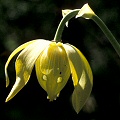Q: How do I make my plant a cultivar?
A: As I described in a previous FAQ entry,
a cultivar is a plant recognized for its special, superior qualities. If you
want to register your plant name as a cultivar, let me discourage you! You see, looking at the cultivar names being established the last several years, I
think most are not worth the paper they're printed on.
But if you REALLY think you have a worthwhile plant, consider the following
questions.
- What is your motivation?
We are all very fond of our plants and want other people to recognize their fine qualities, but why do you want to register your plant name? Nearly all our carnivorous plants are lovely. You should register only the best.
Are you a plant breeder and want to market your latest development? Fine, register the plant name. Is the plant in question already in cultivation under a nick-name, has unique characteristics, and you would like to validate it with a cultivar name? Fine, register the name. Do you have a plant you really like, and you want to give it a cultivar name so other people will recognize it as a nice plant? Not so fine---this vanity motivation is not helpful and detracts from the notion of a cultivar.
- Is the selection securely in cultivation?
A plant name should not be registered if only a few specimens exist. They might easily be killed by a cultivation error! At least a few dozen specimens of the potential cultivar should be in cultivation, and should be under the care of several different growers. The Pinguicula hybrid on this page was slated for cultivar registration, but alas died in cultivation during a bad season. It is a good thing that (expensive) pages of a plant journal were not wasted publishing this unfortunate plant. Sarracenia oreophila 'Don Schnell' was named based upon a single plant, which subsequently died before it could be propagated. Alas! - Is the plant deserving?
Is the plant truly superior, and do specimens maintain these superior attributes year after year? Does the plant retain the superior attributes when cultivated by different growers? If so, the attributes are likely stable; if not, they may be due to your particular conditions. (It would be foolish to describe a cultivar for an average plant which is just being grown well.) - Are you qualified?
Let me be blunt. While on one hand I am pleased that anyone can register cultivar names, I think that enthusiastic beginning horticulturists should avoid registering plants until they have a bit of experience. When I began growing carnivorous plants, I simply did not have the experience to recognize what was a beautiful plant, and the real rarity that should be given a cultivar name. I think you should consider registering a plant as a cultivar only after you have grown that plant and numerous others in the same genus for five years, minimum! I named my first cultivar after growing carnivorous plants for 13 years.

Pinguicula hybrid

'Othello'
If you wish to proceed with your cultivar validation, you have to do the following tasks, which are set out in the International Code of Nomenclature for Cultivated Plants (ICNCP):
- Name the plant! Trickier than it may seem, some rules are:
Three words or less;
If descriptive, it must be clear ("Purple" is unacceptable, "Purple Leaf" is acceptable);
It cannot be in Latin;
It cannot be a subjective promise (i.e., "Super-perfect");
Other rules apply, see the ICNCP rules.
- Write a cultivar description! This should include information such as:
Plant parentage (if known);
The person (originator) who developed the plant, and when they collected or produced it;
If collected, indicate the location of the collection;
The person (nominant) who named the plant, and the date they did so;
Any awards the plant may have garnered;
Any patents, trademarks, plant breeder's rights, etc., associated with the plant (include relevant dates);
The characteristics that make the plant exceptional;
The characteristics that make the plant different from related cultivars;
For cultivars, name any cultivar-groups that it should be included within;
Provide the etymology (origin or meaning) of the proposed cultivar name;
Any other names the plant may be known by (important if the plant is already in circulation).
- Produce a "Standard"! In carnivorous plants, this is a publishable photograph:
The photograph should be of exceptional focus, clarity, and composition;
If color is important, the photograph should reproduce it as faithfully as possible;
The photograph must illustrate the characteristics that make the plant special--more than one photograph is rarely needed.
- Publish the article!
Simply put, it must be published in a book or journal of substantial distribution. Web or newspaper publications are not adequate. Most carnivorous plant journals produced by national societies (and certainly the ICPS) are adequate.
- Register the cultivar name!
Once the article is printed, the cultivar name must be registered by sending a color photocopy of the article to the International Cultivar Registration Authority. For carnivorous plants, this is the ICPS. If you publish your article in an ICPS journal, this last step is done automatically for you.
You can structure the article however you like, as long as the information needed to complete the description is included in the article. I have written or co-written about twenty cultivar descriptions, and examples are:
- Utricularia 'Asenath Waite':
Short, sweet, and to the point. Most cultivar articles are in this form. - Sarracenia 'Adrian Slack':
Included in an issue commemorating the eponymous British horticulturist, this includes a bit of story-telling. - Darlingtonia 'Othello':
Part of a much larger narrative. This article talks about the philosophy of naming cultivars before it gets to the cultivar description itself.
If you are establishing a cultivar name, visit the ICPS web site
for useful help such as cultivar registration forms. These forms are really only checklists to help you remember all the
information you need to supply in the cultivar descriptions, as summarized above, but they are helpful.
Establishing a cultivar-group name is similar to establishing
a cultivar name. The ICPS can help you with that process, too.
Anyone who wishes to publish a cultivar or cultivar-group should read through
the most recent copy of the International Code of Nomenclature for Cultivated Plants.
Registering a cultivar name is admittedly a little tricky for the first-timer, but it should be, since cultivars
are a real rarity. While I help manage a large conservatory collection, and I grow many carnivorous plants of
my own--while I love them all, none are of a quality I would consider to merit establishment as new cultivars.
Page citations: Brickell, C.D. et al. 2004;
Trehane, P. et al. 1995.